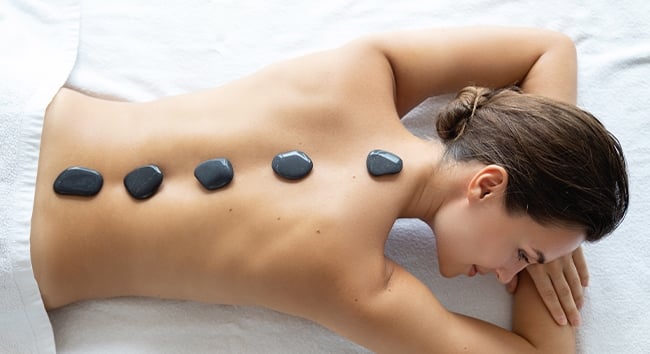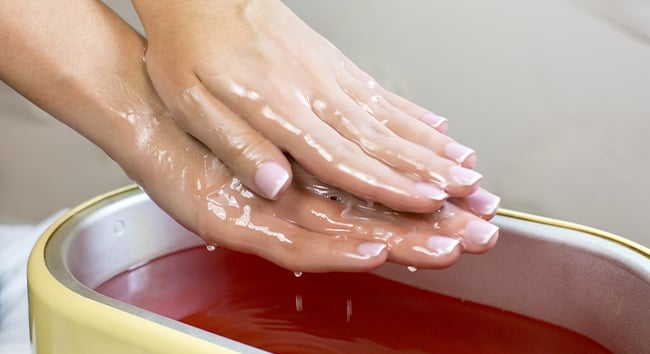Heat Therapy: How And When To Treat Pain With Heat

Remember when you weren’t feeling well and your mom or grandma suggested a heating pad or a warm compress? Ever wonder why? Or ask yourself when you got hurt—is it ice or it heat? We explain the benefits of heat therapy.
Why Heat Therapy
Thermotherapy (heat therapy) is often used to help ease chronic pain (arthritis) and stiffness in the joints and muscles, menstrual cramps, and tension.
Why? Heat increases the flow of blood and oxygen to joints and muscles, which naturally reduces soreness and discomfort, as well as intercepts the transmission of pain signals to the brain. Heat therapy produces a detoxifying sweat at the cellular level, bolsters immune function, strengthens the cardiovascular system, assists in weight loss, rejuvenates the skin, improves sleep, and much more. Heat therapies provide drug-free pain relief and other health benefits, without harmful side effects.
Heat or Ice?
Before considering heat therapy as a remedy, it’s important to know when you should avoid using heat and use ice instead. James A. Devine, Doctor of Chiropractic, of Devine Chiropractic & Rehab Center, explains: “In a nutshell. Never use heat: heating pad, hot creams, hot tub, etc., to treat an acute injury that has happened within the last three days. An acute injury refers to a sudden, severe injury such as a sprained ankle, strained back, or fractured bones. Always put an icepack on it – always!”
Ice helps reduce swelling, while heat helps relax muscles and stiff joints. Heat is better to treat chronic conditions caused from old injuries or arthritis. It’s often used before participating in activities to help loosen up.
Types of Heat Therapy
Dry Heat
Heating pads, infared sauna blankets, dry saunas
Moist Heat*
Hot water bottles, moist heat packets, hot baths, steamy saunas
*Moist heat is often favored over dry heat, as it penetrates deep tissues and muscles quicker. Another plus, moist heat is less likely to dehydrate your skin.
Dry and moist heat therapies can be used to treat a specific area or the full-body. Dry heat applications include heating pads, infrared sauna blankets, and dry saunas. Moist heat treatments that can be used at home include hot water bottles, moist heat packs, a hot tub, or a steamy sauna with rocks. Chiropractic, spa, fitness, or wellness centers may provide these dry and moist heat therapies: infrared saunas, steam rooms, spas, hot stone massage, and ozone sauna therapy.
Popular Heat Therapies & Benefits
Heat therapy can be as simple as applying capsaicin ointment, a heating pad (regular, infrared, or weighted), steamed towel, or heated gel pack, or wearing a heat patch or wrap to ease pain in your back, neck, shoulder, or leg. There’s even a heated massage pillow on the market that’ll give you a soothing, warm deep tissue massage at home, work, or when traveling.
The effectiveness and benefits of each heat modality varies; some extend beyond pain relief. It is recommended that you do a little research to find one that offers the benefits you’re looking for.
Here’s a list of popular heat treatments. These are readily available for use at home or in professional settings.
- Heated Paraffin Wax Treatment – Moist heat and warm melted wax are applied to stiff, painful joints in the hands, wrists, and feet. It is beneficial in relieving arthritic pain and as an exfoliating, moisturizing treatment for dry, cracked, or chapped skin. While some manicurists offer this treatment, small, heated paraffin spas are available online and in retail stores for soothing at-home treatments.

- Hot Stone Massage – Smooth basalt stones are heated and placed on the body by a licensed massage therapist while you recline. Therapeutic oils are used along with warm stones to perform this relaxing, deep tissue massage.
- Infrared Sauna Blanket – This blanket utilizes the same technology as an infrared sauna, but in a blanket that you can lay on your bed and crawl into like a cocoon for a relaxing 30-minute session. The benefits include detoxing at the cellular level, boosting immune function, burning mega calories without working out, reducing inflammation and stress, and rejuvenating the skin. (The sauna blanket is popular among athletes and celebrities.)
- Whirlpools, Hot Tubs, and Jacuzzis- These therapies combine heat (thermotherapy) with water (hydrotherapy) to relax muscle spasms and decrease joint pain and stiffness. Whirlpool jets add a mild massage to the relaxing experience. Soaking in a hot tub or spa bath may also help improve your sleep.
- Regular (Dry) Sauna vs. Infrared Sauna – Both saunas are enclosed by wood; the main difference is in how they heat. A traditional dry sauna heats the air around you, while an infrared sauna heats your body instead. The infrared sauna causes you to sweat at lower temperatures and to a deeper, detoxifying level than a regular sauna. If you’re considering installing one at home, dry saunas require more power, making them more costly to run. A few more reasons to use a sauna include boosting immune function, relieving muscle soreness and joint pain, and clearing congestion.

- Steam Room – Sitting in a heated steam room not only reduces stress, but improves circulation, which may help lower high blood pressure, and improve cardiovascular health. It is also useful in clearing sinus and lung congestion.
- Ozone Sauna Therapy – More wellness centers are offering ozone sauna therapy, with its cutting-edge, advanced detox, immune-boosting, healing, revitalizing technology. What can you expect during an ozone therapy session? Wearing a towel, you’ll sit comfortably in a steam sauna chamber that envelopes your body. Only your head is exposed. Ozone sessions generally last 30 minutes. Ozonated steam and far-infrared rays (FIR) cover and heat your body as you sweat toxins out, including heavy metals. This therapeutic system also enhances blood and lymph circulation, reduces joint and muscle pain, energizes as it reduces stress, enhances immune and organ function, healing, and hormone and enzyme production. Drink water before and after your session to aid in the detox process. The ozone will continue to penetrate the pores in your skin, so it’s beneficial to wait for several hours after a session before showering.
Quick Safety Notes
When using heat therapy, be careful to avoid burns. Heat should penetrate and soothe, but not be uncomfortably hot. Keep track of the time. Set a timer, in case you fall asleep. Do not utilize heat therapies on open wounds or sores, burns, or red, inflamed skin; if you have swelling or untreated high blood pressure; if you have diabetic neuropathy; or if you have lost feeling in your hands or feet. Saunas, hot tubs, and steam rooms shouldn’t be used prior to working out, but post-workout. Consult your health professional before trying heat therapy if you have a serious health condition.
Join The Discussion!
Have you ever used heat therapy to heal?
What is one method that you use?
What is one thing you learned today?
Let us know in the comments below!

Deborah Tukua
Deborah Tukua is a natural living, healthy lifestyle writer and author of 7 non-fiction books, including Pearls of Garden Wisdom: Time-Saving Tips and Techniques from a Country Home, Pearls of Country Wisdom: Hints from a Small Town on Keeping Garden and Home, and Naturally Sweet Blender Treats. Tukua has been a writer for the Farmers' Almanac since 2004.






The interplay between heat and the human body is a tale as old as time, but exploring thermotherapy here unveils its layered intricacies. The science of using heat as an elixir, not just for chronic pain but as a multifaceted tool for wellness, becomes evident. From the simple comfort of a warm compress to the advanced detoxification benefits of ozone sauna therapy, heat’s therapeutic embrace promises more than momentary relief. It speaks of age-old wisdom, where warmth doesn’t merely touch the skin but courses through our circulatory system, intercepting pain, rejuvenating tissues, and detoxifying our core. This reminds us of the dance between ancient remedies and contemporary knowledge, emphasizing that the real power lies in understanding when and how to harness nature’s tools for holistic health.
Thank you for sharing this. We love to hear our readers perspectives, and this one warms our heart.
We grew up with warm salt packs. Heath a pound or two of salt in a frying pan, stirring continuously to keep the salt from burning. Heat it till it feel extra warm to the touch but not hot. Then pour it into an old pillow case and fold and roll the case (you can tie it off at the middle if you’re worried about the salt pouring out). Then place it on the achy area you want to treat. Great for headaches and aching neck and shoulders. Salt packs are more relaxing than you can believe 🙂 And as it cools just unroll the case. Sleep with it? No problem. Then store the salt pack to you need to reheat it. If you don’t scorch the salt it will last for months. For sinus headaches put a little Vick’s Vaporub on your forehead then a dry facecloth to protect the salt bag. Ooo almost instant relief.
Very interesting! Thank you for sharing!